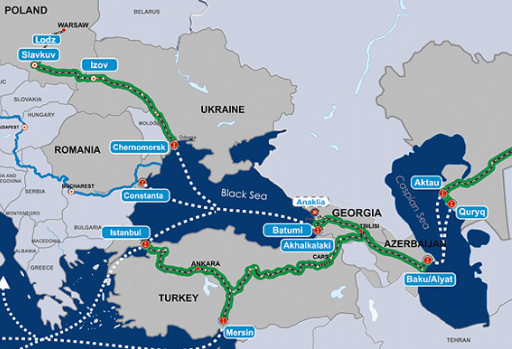The Trans-Caspian International Transport Corridor, or the Middle Corridor, is a key portion of the broad One Belt One Road initiative, which is a strategically important transport route connecting China with Europe through Central Asia and Azerbaijan. With a multifaceted significance for all these regions, the project has a profound impact on economic development, political stability, and cultural cooperation.
We have been seeing substantial progress in the construction of the Trans-Caspian Corridor over the past few years, which has played a key role in strengthening liaison among the regions, contributing to economic prosperity, and enhancing the resilience of the global supply chain. 2022 became a pivotal year, as the construction along the corridor was accelerated, making it prominent in rail links between China and Europe and strengthening infrastructural and trade ties.
Train traffic from Chinese cities such as Xi'an, Urumqi and Jinhua currently run through the MC. Maritime cooperation also plays a crucial role. For instance, our two countries enhanced cooperation among the Shandong Group of Ports, the Port of Qingdao, and the Port of Baku in 2023, which will contribute to development of smart green ports and boost cargo traffic through the corridor.
Chinese President Xi Jinping spoke at the opening of the Third Belt and Road Forum for International Cooperation in October 2023, emphasizing China’s intention to intensify the high-quality development of railway communication between China and Europe and to participate in the Trans-Caspian Corridor. China intends to cooperate with Azerbaijan in building the corridor, boosting efficiency of cross-border cargo traffic, and expanding regional ties, which will promote economic development and improve quality of life of the population in countries along the route.
The MC is a vital element for China to expand trade and economic ties with the west. It offers a shorter alternative route to European markets compared to the traditional sea routes, thus significantly cutting delivery times. This will boost marketability of the Chinese goods in Europe and contribute to the development of western regions in the country, stimulating their economic growth.
At the crossroads between East and West, Azerbaijan plays a central part in the MC. The corridor enhances Azerbaijan’s strategic importance in regional and international trade relations, facilitating economic and infrastructural growth. It also provides Azerbaijan with an access to new markets and opportunities to export goods and services.
For Central Asia, the MC is a door to unique opportunities for economic growth and integration into the global economy, thus allowing these countries to export goods and natural resources to European markets and boosting their allure for foreign investment. Moreover, they will also develop transport infrastructure and increase transit potential, thus strengthening their geopolitical position.
Europe sees the Middle Corridor as an efficient alternative import route from China and Central Asia, which will diversify trade paths and reduce dependence on traditional sea routes, which is especially crucial in the context of global political and economic instability. The corridor also encourages economic ties between Europe and countries along the route, thereby boosting political and economic cooperation on the continent.
Ultimately, the Middle Corridor plays a fundamental role in building new economic dynamics and strengthening cross-cultural interaction between Asia and Europe, offering unique benefits to each stakeholder.
Wang Qi, Executive Director of the Joint Institute for China-Russia Strategic Cooperation, Tshinghua University, especially for AzVision.Az.
More about:















































